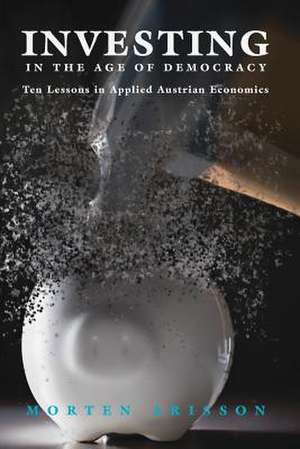Investing in the Age of Democracy: Ten Lessons in Applied Austrian Economics
Autor Morten Arissonen Limba Engleză Paperback – 20 sep 2018
This book offers a historical review of these interventions, to shed light on how we went from what was common sense to the status quo. Offering a sometimes technical analysis, the book examines a series of fundamental investment fallacies, their origins and how not to fall for them.
Preț: 130.90 lei
Nou
Puncte Express: 196
Preț estimativ în valută:
25.05€ • 26.22$ • 20.73£
25.05€ • 26.22$ • 20.73£
Carte disponibilă
Livrare economică 17-31 martie
Preluare comenzi: 021 569.72.76
Specificații
ISBN-13: 9783319959023
ISBN-10: 3319959026
Pagini: 168
Ilustrații: XIX, 167 p. 36 illus.
Dimensiuni: 155 x 235 x 20 mm
Greutate: 0.27 kg
Ediția:1st ed. 2018
Editura: Springer International Publishing
Colecția Palgrave Macmillan
Locul publicării:Cham, Switzerland
ISBN-10: 3319959026
Pagini: 168
Ilustrații: XIX, 167 p. 36 illus.
Dimensiuni: 155 x 235 x 20 mm
Greutate: 0.27 kg
Ediția:1st ed. 2018
Editura: Springer International Publishing
Colecția Palgrave Macmillan
Locul publicării:Cham, Switzerland
Cuprins
Introduction.- PART I: The Current Paradigm.- 1. Lesson 1: Working with the Wrong Tools.- PART II: Fundamentals.- 2. Lesson 2: Asset Allocation is Intertemporal Preference.- 3. Lesson 3: Turing's Decidability.- 4. Lesson 4: Equity.- 5. Lesson 5: Debt.- 6. Lesson 6: Institutions.- PART III: Economic Concepts.- 7. Lesson 7: Systemic Risk.- 8. Lesson 8: Inflation and Hyperinflation.- 9. Lesson 9: Real Capital Assets.- 10. Lesson 10: Economic Growth.- 11. Conclusion.
Notă biografică
Morten Arisson is a Canadian economist, with a Master’s Degree in Business Administration. He has experience in credit portfolio management, private equity and strategy consulting.
Textul de pe ultima copertă
This book offers a structured, deductive approach to Austrian investing, beginning with an analysis of the current investing paradigm. There are five economic concepts on which the Austrian School of Economics has a unique view: Entrepreneurship, Class Probability, Capital, the Interest Rate, and Institutions. This book explains, lesson by lesson, how each of theseshapes our thinking about investing. If we follow them through their logical consequences, they leave us with a unique approach to investing. Except for the theory of probability, there has not been a comprehensive analysis of the linkages between these concepts, when it comes to investing. Although they would have been obvious to the average investor before the age of democracy, since the French and American revolutions, government interventions have steadily transformed the way we think about them (and the way we invest). Above all, Entrepreneurship and Institutions are downplayed today, while investors use Case Probability, and confuse the concepts of Money and Capital.
This book offers a historical review of these interventions, to shed light on how we went from what was common sense to the status quo. Offering a sometimes technical analysis, the book examines a series of fundamental investment fallacies, their origins and how not to fall for them.
This book offers a historical review of these interventions, to shed light on how we went from what was common sense to the status quo. Offering a sometimes technical analysis, the book examines a series of fundamental investment fallacies, their origins and how not to fall for them.
Caracteristici
Offers a structured, deductive approach to Austrian investing, beginning with an analysis of the current investing paradigm Explores key investing themes from mathematics to probability theory to law and explains the importance of investing in debt Showcases the five economic concepts on which the ASE has a unique view: Entrepreneurship, Class Probability, Capital, the Interest Rate, and Institutions
